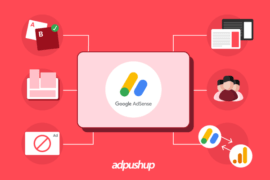Looking forward to maximizing your ad revenue, but puzzled between Adsense vs Ad Exchange? Look no further than this blog. Here, we’ve delved into the nuances that set these two ad platforms apart, exploring their histories and more to help you make an informed decision.
In the ever-evolving world of digital advertising, two terms often thrown around are Google AdSense vs Ad Exchange. While both these platforms offer advertising solutions to publishers and advertisers, they both have different access capabilities, payment models, and more. Thus, it makes sense why Ad Exchange vs Adsense is one of the most common questions in the industry.
One of the major reasons why publishers often seek to understand the differences between AdSense and Ad Exchange is to discover the best approach to maximize revenue potential.
By understanding the differences between these two advertising options, publishers can make informed decisions that align with their revenue goals and ultimately enhance their profitability.
However, when it comes to Adsense vs Ad Exchange, things can get perplexing. On one hand, AdSense is a popular choice for publishers and advertisers alike, thanks to its ease of use and accessibility. On the other hand, AdX offers more control and revenue generation potential but requires more expertise to operate effectively.
While AdSense is a more popular choice among smaller publishers and businesses due to its simplicity and ease of use, AdX is a more popular choice for large-scale publishers who are looking for more control and revenue generation potential.
To fully understand the advantages and disadvantages of each platform, it’s important to dive deep into their respective features.
In this blog, we will explore the key differences between Google AdX and AdSense and help you decide which is best suited for your needs. Without further ado, let’s get started.
Adsense vs Ad Exchange: The History of Advertising
DoubleClick was launched in 1996 as an independent brand offering ad-serving services. Then in 2008, Google acquired DoubleClick for $3.1 billion.
The idea was to bring publishers, advertisers, and agencies together so that everyone can make money out of the ad industry. DoubleClick further expanded and we got DoubleClick for Publisher (DFP) and DoubleClick Ad Exchange.
Since we are here to discuss the difference between DoubleClick AdX and AdSense, DFP will remain out of this.
Talking about AdSense, it was released on June 2003. Since then, it became very popular amongst publishers. It might be because AdSense is a free service available that publishers use to display ads on their websites. Also, AdSense is relatively easy to use for small and medium-sized publishers. However, you can definitely check out some of the best alternatives to Google Adsense.
Even though DoubleClick is older, AdSense is clearly more popular than the DoubleClick. However, it doesn’t mean AdSense is better or DoubleClick is not. AdSense and DoubleClick Ad Exchange carry out two different jobs entirely.
For a publisher, AdSense may sound like a medium to display ads on his/her website. But in reality, AdSense is an ad network whereas AdX is an ad exchange network – which are two different things.
What are Adsense and Adx Exactly?
AdSense is a self-managed platform to run ads. Once AdSense approves you (publisher), you’ll get the ad tag that you need to place it on your website. However, AdSense often seems to benefit advertisers more than publishers.
That’s because AdSense ads are rendered from Google Ads (or Google Adwords). And Adwords is designed to offer low-cost impressions. Also, AdSense doesn’t provide publishers with the option to set a floor price, which means they wouldn’t be able to utilize the inventory.
Also read: Google AdSense: Guide to Improve your Existing Revenue
Google AdX (aka Google Ad Exchange, aka DoubleClick Ad Exchange) is an ad exchange network that brings publishers, advertisers, and agencies together. AdX primarily focuses on providing real-time biddings, private auctions, and preferred deals.
This increases the competition for the inventory and as a result, publishers make good money.
Once you understand what AdSense and Adx are, dive into the major points of difference between them. Mostly, the following points are asked:
How To Get Started With Adsense & Ad Exchange?
How to Get Started with AdSense?
To get started with AdSense, simply go to the AdSense webpage and click on the sign-in button (you would require a Google account for that). Next, submit your website details and wait for AdSense to approve your website. You should receive an email from AdSense in a few days.
Once done, copy the ad tags provided by AdSense and place it on your website’s code to display ads. The service is free and AdSense manages everything, from the placement of ads to payment.
How to Get Started with AdX?
It’s tricky to get started with Google AdX. For starters, it asks for minimum 5 million monthly pageviews along with other eligibility criteria. Then, a publisher need to have a Google Ad Manager account and wait for approval.
However, publishers can also access AdX working with a Google Certified Publishing Partner (such as AdPushup). Along with the AdX marketplace, publishers can also take advantage of demand partners offered by their GCPP.
Here are detailed steps to follow to get access to Google Ad Exchange
Publishers can run AdSense and AdX together using Google Ad Manager. This improves the competition in the inventory.
Also Read – How to Use Google Ad Manager with AdSense and Ad Exchange
AdSense vs Ad Exchange: Understanding the Differences
Now that you know the history of both these platforms, let’s delve deeper into Adsesne vs Ad Exchange and understand their differences.
Services Provided and Accessibilities
When using Google AdSense, Google manages the ads displayed on your website. You can change the size and type of ads if you want. It allows publishers to also block URLs (which is not recommended).
Publisher’s accessibility is limited when using AdSense. However, on the positive side, AdSense manages ad placement, ad targeting (to show relevant ads), and payment for publishers.
DoubleClick Ad Exchange has its own network of publishers, advertisers, and third-party ad networks. Unlike AdSense, publishers need to manage their inventory (like giving the floor price for auctions and carrying out preferred deals by choosing advertisers).
Also, AdX allows publishers to put up to five ad units on a web page. These ad units can be edited (ad size, ad type, format, restrict advertiser/URL, and more) as per the publishers’ requirements.
Google Ads Payment Methods: Which One Offers More?
AdSense and AdX are very different when it comes to paying the publishers. With AdSense, if publishers have crossed the minimum payment threshold, the payment would be initiated. Usually, it starts with 21 days payment processing period.
Once that’s over, the publisher gets the payment within 5 to 7 days. Whereas with AdX, once the minimum threshold is met, payment is credited by the end of that month.
Revenue generation from ad inventory depends on too many factors that it’s hard to pick one and say “This method makes more money”.
However, the data collected by Animation by evaluating the performance of 400+ websites showed, AdX generated more revenue than AdSense.
Ad Platform Selection by Geo: AdX for Tier 1 and AdSense for Tier 3
Ad Exchange Works Better for Tier 1 Geos
If you’re targeting tier 1 Geos, AdX may be the better choice as it can potentially deliver higher earnings. By utilizing AdX’s dynamic flooring, Google Open Bidding, and preferred deals, publishers can optimize their ad performance and expect a significant boost in revenue, ranging from 20-50%.
With AdSense, publishers may need more optimization options to maximize ad revenue. AdX, on the other hand, offers a range of tools that allow publishers to fine-tune their ads and achieve higher earnings. If you’re a publisher eligible for Ad Exchange and are looking to increase your online advertising revenue, consider trying AdX.
Adsense Works Better for Tier 3 Geos
For targeting tier 3 Geos, AdSense is often the better choice over AdX. AdSense tends to outperform AdX in these markets, delivering higher ad revenue for publishers. While AdX offers powerful optimization tools like dynamic flooring and Google Open Bidding, these features may be less effective in tier 3 Geos, where advertisers compete less for ad inventories.
Therefore, for publishers targeting these markets, AdSense is likely the optimal solution for maximizing ad revenue.
Comparing Control: Which Ad Platform Offers Greater Control?
Speaking of AdSense vs Ad Exchange, we must mention that Ad Exchange gives publishers greater control over the ad inventory. While AdSense automatically places ads on publishers’ websites, Ad Exchange allows publishers to place ads manually and have more say in selling and displaying them.
Here is why:
Ad Exchange allows publishers to set their floor prices and sell their ad inventory directly to specific advertisers or brands. This level of control offered by Ad Exchange allows publishers to optimize their revenue and ensure that their ads are displayed in a way that aligns with their overall business strategy. It is something you can’t do in AdSense.
Therefore, if you’re a publisher needing more control and flexibility over your ad inventory, Ad Exchange may be the better choice for you. However, it’s important to note that Ad Exchange requires publishers to spend more time and effort to manage it effectively. So, weighing the benefits against the potential challenges is important before deciding.
Ease of Use and Technical Expertise
For publishers lacking experience with an ad exchange, operating AdX can be challenging. The platform’s complexity may require the assistance of an AdX partner, or advertising operations expert. Without sufficient knowledge on AdX, publishers may struggle to navigate the platform and optimize their ad operations.
On the other hand, AdSense is known for its user-friendly interface and ease of use.
However, large-scale publishers may benefit from using AdX to better manage their ad operations and use advanced optimization tools. If you’re eligible for AdX and have the resources to support its implementation, it may be worth considering as a solution for maximizing your ad revenue.
Now that you better understand Adsense vs Ad Exchange, let’s summarize the key differences in the following table.
Here are some key points to note for AdSense vs Ad Exchange:
Google AdSense vs Ad Exchange: Differences in a Nutshell
| Google AdSense | Google Ad Exchange | |
| Platform Access | Sign up for an AdSense account through the AdSense website. | Must have a Google Ad Manager account to access AdX. |
| Eligibility | Open to all publishers, regardless of size or traffic. | Typically suited for larger publishers or those with complex advertising needs. |
| Ad Inventory | Place AdSense code on the website to display ads. | Must have ad inventory available for sale through Ad Manager. |
| Revenue Share | AdSense takes a percentage of revenue earned from ads. | Ad Exchange provides publishers with more control over pricing and revenue. |
| Ad Formats | Offers a range of ad formats, including display, text, and video ads. | Supports a wider range of ad formats, including programmatic and real-time bidding. |
| Ad quality Control | AdSense has strict policies in place to ensure high-quality ads are displayed. | Ad Exchange allows publishers to set their own policies and control which ads are displayed. |
| Payment Threshold | Payments are made monthly once a minimum threshold has been reached. | Payments are made through Ad Manager once a minimum threshold has been reached. |
| Additional Features | AdSense offers a range of additional features, including AdSense for search and AdSense for video. | Ad Exchange offers advanced tools for managing ad inventory and creating private auctions for specific advertisers. |
Also read: How to Use Google Ad Manager with AdSense and Ad Exchange
Speaking of AdSense vs Ad Exchange, we can’t miss out on how exactly the inventory is bought on these platforms. Take a look:
How Is Ad Inventory is Bought Through AdSense & Ad Exchange?
Media buyers or advertisers work with Google Ad Exchange (AdX) and Google AdSense by using demand-side platforms (DSPs) to purchase ad inventory.
AdX provides media buyers access to premium inventory from top publishers with high traffic. On the other hand, AdSense offers a wider range of inventory from smaller publishers.
These media buyers use DSPs to target specific audiences, optimize campaigns, and track performance across both platforms. The goal is to maximize their advertising investments and achieve better results.
Adsense vs Ad Exchange: What Should I Choose?
AdX is all about real-time deals, private auctions, and preferred deals. Here, multiple advertisers bid for the inventory in real time. This increases competition and revenue generation.
Whereas, AdSense is the largest ad network of small and medium-sized publishers. It’s easy to get started and serve automatic text, image, video, or interactive media advertisements, that are targeted to the site content and audience.
Who should go for AdSense?
Publishers with fewer page views, small to medium business size, not much time or bandwidth to manage ads, and lack of technical knowledge; should choose AdSense.
Who should go for AdX?
Large publishers with high page views, who can manage ad placement and monetization; should choose AdX. Also, if you get approval to join DoubleClick.
Although, managing AdX can be too much for publishers. For that, you may have to hire a third-party. Alternatively, publishers can just switch back to Google AdSense without any significant effect on their earnings.
Frequently Asked Questions: Adsense vs Ad Exchange
Google AdX or DoubleClick Ad Exchange is an ad exchange network. In other words, it is a programmatic advertising platform that offers real-time bidding (RTB) on ad spaces to ad networks.
Google Adsense is an advertising network. It provides a way for publishers to monetize their online content. AdSense works by matching images, videos, or interactive ads on a publisher’s site by matching their content and audience type.
AdSense is a free service available that publishers use to display ads on their websites. Also, AdSense is relatively easy to use for small and medium-sized publishers.

Deepak has a keen eye for detail and a deep understanding of the ad tech landscape. Whether it’s through in-depth articles, thought-provoking insights, or compelling storytelling, he’s dedicated to helping people navigate the complex world of ad tech with the simplicity of his words.







